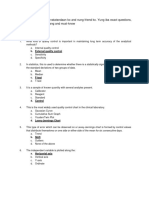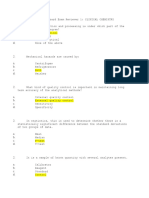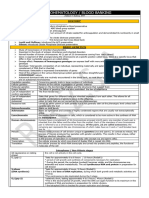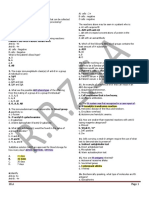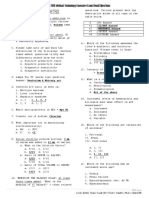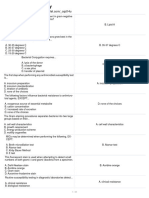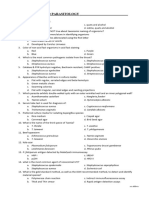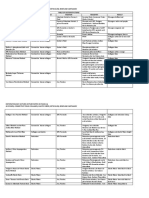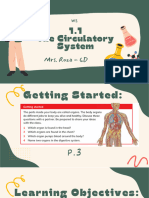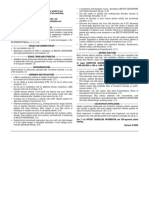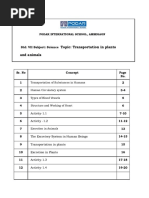Preboards Hematology
Preboards Hematology
Uploaded by
Kaius KawaseCopyright:
Available Formats
Preboards Hematology
Preboards Hematology
Uploaded by
Kaius KawaseOriginal Title
Copyright
Available Formats
Share this document
Did you find this document useful?
Is this content inappropriate?
Copyright:
Available Formats
Preboards Hematology
Preboards Hematology
Uploaded by
Kaius KawaseCopyright:
Available Formats
3/30/22, 8:23 AM Preboards: Hematology 3/30/22, 8:23 AM Preboards: Hematology
Which of the following is not associated with hereditary spherocytosis? 1 point
Preboards: Hematology
Extravascular hemolysis
myca.yanes.up@phinmaed.com Switch account
Intravasular hemolysis
An MCHC greater than 36%
Choose the best answer. Good luck! Increased osmotic fragility
Qualitative and quantitative neutrophil changes noted in response to 1 point
infection include all of the following except:
A peripheral smear shows 75% blasts. These stain positive for both Sudan 1 point
Neutrophilia Black B(SBB) and peroxidase. Given these values, which of the following
disorders is most likely?
Pelgeroid hyposegmentation
Acute myelocytic leukemia
Toxic granulation
CML
Vacuolization
Acute undifferetiated leukemia
Acute lymphocytic leukemia
Which of the following factors is not present in BaSO4 adsorbed plasma? 1 point
VIII
In a patient with human immunodeficiency virus (HIV) infection, one should 1 point
II expect to see:
XII Reactive lymphocytes
V Target cells
Pelgeroid cells
Shift to the in WBCs
Which of the following is a characteristic of Auer rods? 1 point
They are nonspecific esterase positive
Seen in chronic myelogenous leukemia
Stain periodic-acid-Schiff (PAS) positive
Composed of azurophilic granules
https://docs.google.com/forms/d/e/1FAIpQLScH5jjlpX5BJQYAjNtBFS1cGqdDYPSeuzoyBtKEy0BJwn_qwQ/formResponse 1/35 https://docs.google.com/forms/d/e/1FAIpQLScH5jjlpX5BJQYAjNtBFS1cGqdDYPSeuzoyBtKEy0BJwn_qwQ/formResponse 2/35
3/30/22, 8:23 AM Preboards: Hematology 3/30/22, 8:23 AM Preboards: Hematology
What influence does the Philadelphia (Ph1)chromosome have on the 1 point What would be the most likely designation by the WHO for the FAB AML 1 point
prognosis of patients with chronic myelocytic leukemia? M2 by the French-American-British classification?
It is not predictive AML with t(15;17)
The prognosis is worse if Ph1 is present AML with inv(16)
The prognosis is better if Ph1 is present AML with mixed lineage
The disease usually transforms into AML when Ph1 is present AML with t(8;21)
Sodium fluoride may be added to the naphthyl AD acetate (NASDA) 1 point Causes of monocytosis: 1. SBE 2. Tuberculosis 3. Syphilis 4. IM 1 point
esterase reaction. The fluoride is added to inhibit a positive reaction with:
1, 2 and 3
Erythrocytes
1 and 3
Megakaryocytes
4 only
Monocytes
1, 2, 3 and 4
Granulocytes
Glanzmann's thrombasthenia: 1 point
Causes of thrombocytopenia, except: I. Decreased platelet production II. 1 point
Decreased platelet survival time III. Increased platelet sequestration by the Normal aggregation to ADP, epinephrine and collagen, abnormal ristocetin
spleen IV. Multiple blood transfusions
Normal aggregation to ristocetin, abnormal to ADP, epinephrine and collagen
I, II, and III
Normal in all aggregating agents
II, III, IV
None of the aggregating agents
I, III, and IV
I, II, III and IV
None of the above
https://docs.google.com/forms/d/e/1FAIpQLScH5jjlpX5BJQYAjNtBFS1cGqdDYPSeuzoyBtKEy0BJwn_qwQ/formResponse 3/35 https://docs.google.com/forms/d/e/1FAIpQLScH5jjlpX5BJQYAjNtBFS1cGqdDYPSeuzoyBtKEy0BJwn_qwQ/formResponse 4/35
3/30/22, 8:23 AM Preboards: Hematology 3/30/22, 8:23 AM Preboards: Hematology
A characteristic starry-sky pattern is commonly seen in what precursor B- 1 point In leukemia, which term describes a peripheral blood finding of 1 point
cell neoplasm? leukocytosis with a shift to the left, accompanied by nucleated red cells?
Follicular Lymphoma Megaloblastosis
Burkitt’s Lymphoma Myelophthisis
Diffuse Large B-cell Lymphoma Dysplasia
Small Lymphocytic Lymphoma Leukoerythroblastosis
Neutrophil phagocytosis and particle ingestion are associated with an 1 point Decreased platelet production, except: I. Fanconi's syndrome II. TAR 1 point
increase in oxygen utilization called respiratory burst. What are the two syndrome III. Chronic alcohol consumption IV. Myelofibrosis
most important products of this biochemical reaction?
I, II and III
Cytochrome b and collagenase
II, III, and IV
Lactoferrin and NADPH oxidase
I, III and IV
Hydrogen peroxide and superoxide anion
All of the above
Alkaline phosphatase and ascorbic acid
None of the above
All of the following statements are true about Vascular hemolysis except: 1 point
Which of the following can shift the hemoglobin oxygen dissociation curve 1 point
Macrophage mediated hemolysis occurs most often in the spleen and the liver where to the right?
macrophages possess receptors for those markers
Increases in 2,3-DPG
Protoporphyrin IX is the base substance from which unconjugated bilirubin is derived
Acidosis
in Extravascular hemolysis, Macrophage ingests a portion of the membrane, leaving
RBC to reseal with decreased membrane and therefore a RBC with decreased surface Hypoxia
area.
All of these options
When free in plasma, hemoglobin exists mostly alpha/Beta dimers that rapidly
complex to a liver produced plasma protein called Hemopexin.
https://docs.google.com/forms/d/e/1FAIpQLScH5jjlpX5BJQYAjNtBFS1cGqdDYPSeuzoyBtKEy0BJwn_qwQ/formResponse 5/35 https://docs.google.com/forms/d/e/1FAIpQLScH5jjlpX5BJQYAjNtBFS1cGqdDYPSeuzoyBtKEy0BJwn_qwQ/formResponse 6/35
3/30/22, 8:23 AM Preboards: Hematology 3/30/22, 8:23 AM Preboards: Hematology
The following results are obtained from a patient who developed severe 1 point How does a separator gel work as an additive? 1 point
bleeding:
It undergoes a temporary change in viscosity during centrifugation
It Changes the density gradient of the blood
It changes the Specific gravity of the liquid portion during centrifugation
It has a thixotropic property that enables it to pull down the liquid portion of the blood.
Factor VIII concentrate
Fresh frozen plasma
The following laboratory results were obtained on a 25-year-old woman 1 point
Cryoprecipitate with menorrhagia after delivery of her second son. The patient has no
previous bleeding history.
Platelets
All of the following are not true about liver disease, except: I. Multiple 1 point
factor deficiencies II. Abnormal fibrinolysis III. Thrombocytopenia IV.
Qualitative platelet abnormalities
I, II, and III
II, III, and IV Lupus anticoagulant
I, III, and IV Factor VIII deficiency
I, II, III and IV Factor IX deficiency
Factor VIII inhibitor
Which of the following may be seen in the peripheral blood smear of a 1 point
patient with obstructive liver disease?
Microcytes
Macrocytes
Schistocytes
Howell-Jolly bodies
https://docs.google.com/forms/d/e/1FAIpQLScH5jjlpX5BJQYAjNtBFS1cGqdDYPSeuzoyBtKEy0BJwn_qwQ/formResponse 7/35 https://docs.google.com/forms/d/e/1FAIpQLScH5jjlpX5BJQYAjNtBFS1cGqdDYPSeuzoyBtKEy0BJwn_qwQ/formResponse 8/35
3/30/22, 8:23 AM Preboards: Hematology 3/30/22, 8:23 AM Preboards: Hematology
Theo the intern, was able to collect a sample from an uncooperative 1 point All of the following are associated with intravascular hemolysis except: 1 point
patient. Before reaching the lab, he noticed that the blue top tube has tiny
clots. Because he did not want to go back to the same patient again, he Methemoglobinemia
carefully extracted the tiny clot out of the tube and gave it to his staff med
Hemoglobinuria
tech for testing. Which of the following test is most likely not affected?
Hemoglobinemia
Bleeding time
Decreased haptoglobin
Clotting time
5M Urea solubility test
Reptilase test A 7.0-mL ethylenediaminetetraacetic acid (EDTA)tube is received in the 1 point
laboratory containing only2.0 mL of blood. If the laboratory is using manual
techniques, which of the following tests will most likely be erroneous?
Which of the following Antigen Designation is commonly found in T-cells? 1 point RBC count
1. CD42. CD83. CD10 4. CD11
Hemoglobin
a. 1 and 2 are correct
Hct
b. 1, 2, and 3 are correct
WBC count
c. 1 and 3 are correct
d. 1, 2, 3, and 4 are correct
A patient hematocrit from a morning specimen was 0.35 L/L; later that 1 point
afternoon it was 0.40 L/L. Both specimens were collected in EDTA
evacuated tube. Assuming that there should not have been any significant
A manual RBC count is performed on a pleural fluid. The RBC count in the 1 point change in the hematocrit, what is one possible explanation for the
large center square of the Neubauer hemacytometer is 125, and the discrepancy?
dilution is 1:200. What is the total RBC count?
a. The correct order of draw was not followed
62.5 × 10^9/L
b. The tourniquet was applied too long during the first collection
27.8 x 10^9/L
c. The tourniquet was applied too long during the second collection
125.1 x 10^9/L
d. An improper anticoagulant was used
250.0 x 10^9/L
Other:
https://docs.google.com/forms/d/e/1FAIpQLScH5jjlpX5BJQYAjNtBFS1cGqdDYPSeuzoyBtKEy0BJwn_qwQ/formResponse 9/35 https://docs.google.com/forms/d/e/1FAIpQLScH5jjlpX5BJQYAjNtBFS1cGqdDYPSeuzoyBtKEy0BJwn_qwQ/formResponse 10/35
3/30/22, 8:23 AM Preboards: Hematology 3/30/22, 8:23 AM Preboards: Hematology
Christmas disease, except: I. Autosomal recessive II. Plasma or whole blood 1 point Cells that exhibit a positive stain with acid phosphatase and are not 1 point
should be fresh when transfused III. Female carriers experience no inhibited with tartaric acid are characteristically seen in:
bleeding tendencies IV. Sex linked recessive trait
Infectious lymphocytosis
I, II and III
Infectious mononucleosis
II, III, and IV
Hairy cell leukemia
I, II, and IV
T-cell acute lymphoblastic leukemia
I, II, III and IV
Embryonic hemoglobins: 1 point
Which anemia is characterized by a lack of intrinsic factor that prevents B12 1 point
absorption? Portland has 2 zeta and 2 epsilon chains
Transcobalamin deficiency Gower II has 2 alpha and 2 epsilon chains
Tropical sprue Both are correct
Blind loop syndrome Neither is correct
Pernicious anemia
Sample quality flags: 1 point
Bernard-Soulier syndrome: I. Autosomal dominant II. Autosomal recessive 1 point Lipemia
III. Gp IIb-IIIa deficiency IV. Gp Ib deficiency
Icterus
I and II Photooptics error
II and III Specimen track error
I and IV No end point detected
II and IV
https://docs.google.com/forms/d/e/1FAIpQLScH5jjlpX5BJQYAjNtBFS1cGqdDYPSeuzoyBtKEy0BJwn_qwQ/formResponse 11/35 https://docs.google.com/forms/d/e/1FAIpQLScH5jjlpX5BJQYAjNtBFS1cGqdDYPSeuzoyBtKEy0BJwn_qwQ/formResponse 12/35
3/30/22, 8:23 AM Preboards: Hematology 3/30/22, 8:23 AM Preboards: Hematology
Which of the following reactions are often positive in ALL but are negative 1 point A patient has a history of mild hemorrhagic episodes. Laboratory results 1 point
in AML? include a prolonged prothrombin time and activated partial thromboplastin
time. The abnormal prothrombin time was corrected by normal and
Terminal deoxynucleotidyl transferase and PAS adsorbed plasma, but not aged serum. Which of the following coagulation
factors is deficient?
Chloroacetate esterase and nonspecific esterase
prothrombin
Sudan Black B and peroxidase
Factor V
New methylene blue and acid phosphatase
Factor X
Factor VII
Which of the following statements is usually not true? 1 point
The patient has the right to refuse to give a blood specimen
It suggests that all blood cells are derived from a single progenitor cell 1 point
If two unsuccessful attempts at collection have been made, the CLSI recommends
called a pluripotent stem cell
that the phlebotomist seek the assistance of another phlebotomist
Sensitivity to latex should be determined before any phlebotomy procedure Pluriphyletic Theory
The CLSI requires the physician permsission before the blood is drawn from the other Monophyletic Theory
side as a prior mastectomy.
Polyphyletic Theory
Monoblastic
The APTT results are not elevated in a patient receiving heparin. Which of 1 point
the following factors may be associated with the lack of response to
heparin therapy in this patient?
A patient has 80 nucleated red blood cells per 100 leukocytes. In addition 1 point
Protein C deficiency
to increased polychromasia on the peripheral smear, what other finding
maybe present on the CBC?
Protein S deficiency
Increased Hct
Antithrombin deficiency
Increased MCV
Factor VIII deficiency
Increased platelets
Increased red blood cell count
https://docs.google.com/forms/d/e/1FAIpQLScH5jjlpX5BJQYAjNtBFS1cGqdDYPSeuzoyBtKEy0BJwn_qwQ/formResponse 13/35 https://docs.google.com/forms/d/e/1FAIpQLScH5jjlpX5BJQYAjNtBFS1cGqdDYPSeuzoyBtKEy0BJwn_qwQ/formResponse 14/35
3/30/22, 8:23 AM Preboards: Hematology 3/30/22, 8:23 AM Preboards: Hematology
The familial condition of Pelger-Huet anomaly is important to recognize 1 point Prekallikrein deficiency: I. Autosomal recessive II. Autosomal dominant III. 1 point
because this disorder must be differentiated from: Bleeding tendencies IV. Normal PT, TT, and bleeding time
Infectious mononucleosis I, II, and III
A shift-to-the-left increase in immature granulocytes II, III, and IV
May-Hegglin anomaly I, III, and IV
G6PD deficiency I, II, III and IV
In addition to morphology, cytochemistry, and immunophenotyping, the 1 point Bethesda assay is used for which determination? 1 point
WHO classification of myelo- and lymphoproliferative disorders is based
upon which characteristics? Factor VIII inhibitor titer
Cytogenetic abnormalities Factor V Leiden titer
Proteonomics Lupus anticoagulant titer
Carbohydrate-associated tumor antigen production Protein S deficiency
Cell signaling and adhesion markers
A 3-year-old male was admitted to a hospital with scattered petechiae and 1 point
epistaxis. The patient had normal growth and had no other medical
Afibrinogenemia: I. An autosomal recessive trait II. An autosomal dominant 1 point problems except for chicken pox 3 weeks earlier. His family history was
trait III. ESR is 0 IV. Excessive bleeding following surgery or trauma, as well unremarkable.
as gingival bleeding
I, II, and III
II, III and IV
I, III and IV
DIC
I, II, III, and IV
TTP
ITP
HUS
https://docs.google.com/forms/d/e/1FAIpQLScH5jjlpX5BJQYAjNtBFS1cGqdDYPSeuzoyBtKEy0BJwn_qwQ/formResponse 15/35 https://docs.google.com/forms/d/e/1FAIpQLScH5jjlpX5BJQYAjNtBFS1cGqdDYPSeuzoyBtKEy0BJwn_qwQ/formResponse 16/35
3/30/22, 8:23 AM Preboards: Hematology 3/30/22, 8:23 AM Preboards: Hematology
Which AML cytogenetic abnormality is associated with acute 1 point SDS-Page electrophoresis uses what dye to identify the RBC membrane 1 point
myelomonocytic leukemia with marrow eosinophilia under the WHO proteins?
classification of AML with recurrent genetic abnormalities?
A. Amido Black S
AML with t(15;17) B. Coomassie blue dye
AML with inv(16) C. Bromcresol Green
AML with mixed lineage D. Ponceau S
AML with t(8;21)
Which antibiotic(s) is (are) most often implicated in the development of 1 point
aplastic anemia?
A rapid platelet consumption and results in severe thrombocytopenia. In 1 point
addition, levels of factor V, factor VIII, and fibrinogen are decreased as a
Penicillin
result of in vivo thrombin generation. The test for D-dimer (a breakdown
product of stabilized fibrin) almost always yields positive results. Tetracycline
Acute DIC Sulfonamides
Chronic DIC Chloramphenicol
Primary hypercoagulable state
Secondary hypercoagulable state
A laboratory test that s always useful in the differential diagnosis of relative 1 point
and absolute erythrocytosis is:
Hemoglobin electrophoresis
The Coulter principle for counting cells is based upon the fact that: 1 point
Plasma erythropoietin quantification
Cells conduct electricity better than cells do
Hemoglobin quantitation
Conductivity varies proportionally to the number of cells
Red cell mass quantification
Isotonic solutions conduct electricity better than cells do
Isotonic solutions cannot conduct electricity
https://docs.google.com/forms/d/e/1FAIpQLScH5jjlpX5BJQYAjNtBFS1cGqdDYPSeuzoyBtKEy0BJwn_qwQ/formResponse 17/35 https://docs.google.com/forms/d/e/1FAIpQLScH5jjlpX5BJQYAjNtBFS1cGqdDYPSeuzoyBtKEy0BJwn_qwQ/formResponse 18/35
3/30/22, 8:23 AM Preboards: Hematology 3/30/22, 8:23 AM Preboards: Hematology
Insufficient centrifugation will result in: 1 point Compared to a rubricyte, a metarubricyte looks different because of its: 1 point
A false increase in hematocrit (Hct) value Dark blue cytoplasm
No effect on Hct value Larger size
A false decrease in Hct value Pyknotic nucleus
All of these options, depending on the patient Nucleoli
Erythropoiesis: 1 point Thrombocytopenia related to cardiopulmonary bypass, except: I. DIC II. 1 point
Dilution III. Sequestration IV. Increased fibrinolysis
It takes approximately 3 days for the pronormoblast to develop into orthochromic
normoblast I, II, and III
Reticulocytes are held within the bone marrow for an additional 24 hours before it is
II, III, IV
released into the peripheral blood
I, III, and IV
Both are correct
All of the above
Neither is correct
None of the above
All of the following are true about chronic myelogenous leukemia, EXCEPT? 1 point
A differential was performed on an asymptomatic patient. The differential 1 point
There is a presence of a chimeric BCR-ABL gene derived from portions of the BCR
included 60% neutrophils: 55 of which had 2 lobes and 5 had 3 lobes. There
gene on chromosome 22 and the ABL gene on chromosome 9.
were no other abnormalities. This is consistent with which of the following
BCR-ABL is created by a reciprocal (9; 22) (q34; q11) translocation the so called anomalies?
Philadelphia chromosome.
Pelger-Huet
This disorder is a type of Myeloproliferative Disorders.
May-Hegglin
Presence of scattered macrophages with abundant wrinkled, green-blue cytoplasm a
so-called sea-blue histiocytes.
Alder-Reilly
AOTA
Chediak-Higashi
NOTA
https://docs.google.com/forms/d/e/1FAIpQLScH5jjlpX5BJQYAjNtBFS1cGqdDYPSeuzoyBtKEy0BJwn_qwQ/formResponse 19/35 https://docs.google.com/forms/d/e/1FAIpQLScH5jjlpX5BJQYAjNtBFS1cGqdDYPSeuzoyBtKEy0BJwn_qwQ/formResponse 20/35
3/30/22, 8:23 AM Preboards: Hematology 3/30/22, 8:23 AM Preboards: Hematology
Leukemic lymphoblasts reacting with anti-CALLA are characteristically 1 point Used to treat inherited fibrinogen deficiencies: I. Purified fibrinogen II. 1 point
seen in: Cryoprecipitate III. Fresh frozen plasma IV. Platelet concentrate
Null-cell ALL I, II and III
T-cell ALL II, III, and IV
Common ALL I, III and IV
B-cell ALL I, II, III, and IV
Spectrin is a protein that occupies a major role in: 1 point Hemolytic anemia is not indicated by a(an): 1 point
Red cell membrane structure Positive urine hemosiderin
Red cell transport and removal of CO2 Positive fecal occult blood
Reducing ferric iron Increased in plasm unconjuagted bilirubin
Iron recovery during hemoglobin degradation Decreased serum haptoglobin
A 15-year-old girl is taking primaquine for a parasitic infection and notices 1 point Instrument malfunction flags: 1 point
her urine is a brownish color. A CBC shows mild anemia. The laboratorian
performing the reticulocyte count notices numerous irregular shaped Abnormal clot formation
granules near the periphery of the RBC. These cellular inclusions are most
Probe not aspirating
likely:
Temperature error
Howell-Jolly bodies
Photo-optics error
basophilic stippling
Icterus
Heinz bodies
Pappenheimer bodies
https://docs.google.com/forms/d/e/1FAIpQLScH5jjlpX5BJQYAjNtBFS1cGqdDYPSeuzoyBtKEy0BJwn_qwQ/formResponse 21/35 https://docs.google.com/forms/d/e/1FAIpQLScH5jjlpX5BJQYAjNtBFS1cGqdDYPSeuzoyBtKEy0BJwn_qwQ/formResponse 22/35
3/30/22, 8:23 AM Preboards: Hematology 3/30/22, 8:23 AM Preboards: Hematology
In addition to an increase in red blood cells, which of the following is 1 point Disseminated intravascular coagulation (DIC) is most often associated with 1 point
characteristic of polycythemia vera? which of the following types of acute leukemia?
Decreased platelets, decreased granulocytes, decreased erythropoietin level Acute myelomonocytic leukemia
Decreased platelets, decreased granulocytes, increased erythropoietin level Acute myeloid leukemia without maturation
Increased platelets, increased granulocytes, increased erythropoietin level Acute promyelocytic leukemia
Increased platelets, increased granulocytes, decreased erythropoietin level Acute monocytic leukemia
Patients with beta-thalassemia: 1. Normocytic normochromic anemia 3. 1 point I. Superficial bleeding (e.g., petechiae, epistaxis, or gingival bleeding), 1 point
Decreased hemoglobin F 2. Occassional target cells 4. Increased usually associated with a plasma clotting factors deficiencies/disorders II.
hemoglobin A2 Deep tissue bleeding (e.g., hematomas or hemarthrosis), usually
associated with platelet function disorders.
1 and 3
Only statement 1 is true
2 and 4
Only statement 2 is true
1, 2 and 3
Both are true
1, 2, 3 and 4
Both are false
Autoagglutination of red cells at room temperature can cause which of the 1 point
following abnormal test results? Laboratory findings in acute hemolytic anemia: 1. Hemoglobinemia 2. Inc. 1 point
plasma haptoglobin 3. Hemoglobinuria 4. Hematuria
High MCV
1 and 3
Low RBC count
2 and 4
Low hematocrit
1, 2 and 3
All of these options
, 2, 3 and 4
https://docs.google.com/forms/d/e/1FAIpQLScH5jjlpX5BJQYAjNtBFS1cGqdDYPSeuzoyBtKEy0BJwn_qwQ/formResponse 23/35 https://docs.google.com/forms/d/e/1FAIpQLScH5jjlpX5BJQYAjNtBFS1cGqdDYPSeuzoyBtKEy0BJwn_qwQ/formResponse 24/35
3/30/22, 8:23 AM Preboards: Hematology 3/30/22, 8:23 AM Preboards: Hematology
Culling and pitting of erythrocytes in the circulation takes place in the: 1 point A medtech intern saw a mixture of Megalocytes, microcytes and immature 1 point
RBCs on the Blood smear of a patient. Which of the following values will
germinal centers of lymph nodes likely reflect the status of the patient?
cords of red and white pulp and marginal zone of the spleen RDW value of 15.5 %
cortex of the thymus MCHC value of 37
sinuses of the bone marrow RDW value of 14.3%
B and C
With respect to globin chain genes, which of the following statements is 1 point
correct?
A patient on therapeutic warfarin will most likely have a(an): 1 point
The genes for the alpha globin chains are located on chromosome 16 and the genes
for the gamma, delta and beta chains are located on chromosome 11 Normal PT/INR, increased APTT, prolonged bleeding time, low platelet count
The genes for the gamma, delta and beta globin chains are located on chromosome
Increased PT/INR, increased APTT, normal bleeding time, normal platelet count
16 and the genes for the alpha chains are located on chromosome 11
The genes for the alpha globin chains are located on chromosome 10 and the genes Normal PT/INR, normal APTT, normal bleeding time, normal platelet count
for the gamma, delta and beta chains are located on chromosome 15
Increased PT/INR, normal APTT, prolonged bleeding time, low platelet count
The genes for the alpha and delta globin chains are located on chromosome 11 and
the genes for the gamma and beta chains are located on chromosome 16
CML is distinguished from leukemoid reaction by which of the following: 1 point
Which of the following is characteristic of cellular changes as 1 point
CML: high WBC; Leukemoid: normal WBC
megakaryoblasts mature into megakaryocytes within the bone marrow?
CML: high WBC; leukemoid: higher WBC
progressive decrease in overall cell size
CML: low LAP; leukemoid: high LAP
nuclear division without cytoplasmic division
CML high LAP: leukemoid: low LAP
increasing basophilia of cytoplasm
fusion of the nuclear lobes
https://docs.google.com/forms/d/e/1FAIpQLScH5jjlpX5BJQYAjNtBFS1cGqdDYPSeuzoyBtKEy0BJwn_qwQ/formResponse 25/35 https://docs.google.com/forms/d/e/1FAIpQLScH5jjlpX5BJQYAjNtBFS1cGqdDYPSeuzoyBtKEy0BJwn_qwQ/formResponse 26/35
3/30/22, 8:23 AM Preboards: Hematology 3/30/22, 8:23 AM Preboards: Hematology
A prolonged thrombin time and a normal reptilase-R time are characteristic 1 point A correction is necessary for WBC counts when nucleated RBCs are seen 1 point
of: on the peripheral smear because:
Dysfibrinogenemia The RBC count is too low
Increased D-dimer The WBC count would be falsely lower
Therapeutic heparinization Nucleated RBCs are counted as leukocytes
Fibrin monomer split product complexes Nucleated RBCs are confused with giant platelets
What is the normal WBC differential lymphocyte percentage (range) in the 1 point The following are compounds formed in the synthesis of heme: 1. 1 point
adult population? coproporphyrinogen 3. uroporphyrinogen 2. porphobilinogen 4.
protoporphyrinogen Which of the following responses lists these
5% - 10% compounds in the order in which they are formed?
10%-20%
4,3,1,2
20%-44%
2,3,1,4
50%-70%
2,4,3,1
2,1,3,4
A condition in which platelets are always in an “activated” state and 1 point
express phosphatidylserine on the outer leaflet of the membrane without
prior activation. A prolonged thrombin time is indicative of which of the following 1 point
antithrombotic therapies?
Scott syndrome
Heparin
Stormorken syndrome
Clopidogrel
Hermansky-Pudlak Syndrome
Aspirin
Chédiak-Higashi Syndrome
Prasugrel
https://docs.google.com/forms/d/e/1FAIpQLScH5jjlpX5BJQYAjNtBFS1cGqdDYPSeuzoyBtKEy0BJwn_qwQ/formResponse 27/35 https://docs.google.com/forms/d/e/1FAIpQLScH5jjlpX5BJQYAjNtBFS1cGqdDYPSeuzoyBtKEy0BJwn_qwQ/formResponse 28/35
3/30/22, 8:23 AM Preboards: Hematology 3/30/22, 8:23 AM Preboards: Hematology
The abnormally increased hemoglobin electrophoresis value(s) that would 1 point Which of the following is associated with antithrombin deficiency? 1 point
usually exclude the possibility of alpha thalassemia is (are):1. HbA2 2. HbH
3. HbF 4. Hb Barts Bleeding
1 and 3 Thrombocytopenia
2 and 4 Thrombosis
1, 2 and 3 Thrombocytosis
4 only
A 62-year-old female presents withy jaundice and the following laboratory 1 point
data:
The JAK2(V617F) mutation may be positive in all of the following chronic 1 point
myeloproliferative disorders except:
Essential thrombocythemia
Idiopathic myelofibrosis
PV
CML
Inherited factor VII deficiency
Cirrhosis of the liver
This abnormality consists of marked dilation and tortuosity of the surface- 1 point
connecting tubular system (the so-called Swiss cheese platelet). DIC
von Willebrand disease
Hermansky-pudlak syndrome
Wiskott-aldrich syndrome
Chédiak-Higashi Syndrome
Gray platelet syndrome
https://docs.google.com/forms/d/e/1FAIpQLScH5jjlpX5BJQYAjNtBFS1cGqdDYPSeuzoyBtKEy0BJwn_qwQ/formResponse 29/35 https://docs.google.com/forms/d/e/1FAIpQLScH5jjlpX5BJQYAjNtBFS1cGqdDYPSeuzoyBtKEy0BJwn_qwQ/formResponse 30/35
3/30/22, 8:23 AM Preboards: Hematology 3/30/22, 8:23 AM Preboards: Hematology
A rare autosomal recessive disorder characterized by partial 1 point Parahemophilia, except: I. Autosomal recessive disorder II. Congenital 1 point
oculocutaneous albinism, frequent pyogenic bacterial infections, giant deficiency of Factor IX III. Congenital deficiency of Factor V IV.
lysosomal granules in cells of hematologic and non hematologic origin, Heterozygous individuals are usually asymptomatic
platelet dense granule deficiency, and hemorrhage.
I and III
Hermansky-pudlak syndrome
II and IV
Wiskott-aldrich syndrome
I, II and III
Chédiak-Higashi Syndrome
I, II, III, and IV
Gray platelet syndrome
What is the name of the eicosanoid metabolite produced from endothelial 1 point
The Na+ - K+ cation pump is an important mechanism in keeping the red 1 point cells that suppresses platelet activity?
blood cell intact. Its function is to maintain a high level of:
TXA2
Intracellular Na+
Arachidonic acid
Intracellular K+
Cyclooxygenase
Plasma Na+
Prostacyclin
Plasma K+
Features of secondary polycythemia include all of the following except: 1 point
The Mechanism of action of this evacuated tube is to inhibit thrombin 1 point
formation Increased red cell mass
Light blue Increased erythropoeitin
Yellow Decreased oxygen saturation
Green Splenomegaly
Red W/ Gray/Gold
Tan (plastic)
https://docs.google.com/forms/d/e/1FAIpQLScH5jjlpX5BJQYAjNtBFS1cGqdDYPSeuzoyBtKEy0BJwn_qwQ/formResponse 31/35 https://docs.google.com/forms/d/e/1FAIpQLScH5jjlpX5BJQYAjNtBFS1cGqdDYPSeuzoyBtKEy0BJwn_qwQ/formResponse 32/35
3/30/22, 8:23 AM Preboards: Hematology 3/30/22, 8:23 AM Preboards: Hematology
All of the following are synthesized in the Mitochondria, EXcept: 1 point DIC: I. Defibrination syndrome II. Consumption coagulopathy III. Presence 1 point
of schistocytes and microspherocytes IV. Positive D-dimer test
Heme
I, II and III
Protoporphyrin
II, III, and IV
Succinyl CoA + D-ALA
I, III, and IV
Uroporphyrinogen III
I, II, III and IV
In essential thrombocythemia, the platelets are: 1 point
Conditions associated with reactive thrombocytosis, except: I. Blood lost II. 1 point
Increased in number and functionally abnormal Splenectomy III. Inflammation and disease IV. Exercise
Normal in number and functionally abnormal I and II
Decreased in number and functional II and III
Decreased in number and functionally abnormal III and IV
IV and I
All of the above
Relative polycythemia is characterized by:1. Increase total red cell mass 3. 1 point
Normal plasma volume2. Normal total red cell mass 4. Decreased plasma None of the above
volume
1, 2 and 3
A 56-year-old woman was admitted to the hospital with a history of a 1 point
1 and 3
moderate to severe bleeding tendency of a several years’ duration.
2 and 4 Epistaxis and menorrhagia were reported. Prolonged APTT was corrected
with fresh normal plasma, adsorbed plasma, and aged serum. Deficiency of
Only 4 which of the following is most likely?
Factor XII
Factor VIII
Factor XI
Factor IX
Back Submit Clear form
https://docs.google.com/forms/d/e/1FAIpQLScH5jjlpX5BJQYAjNtBFS1cGqdDYPSeuzoyBtKEy0BJwn_qwQ/formResponse 33/35 https://docs.google.com/forms/d/e/1FAIpQLScH5jjlpX5BJQYAjNtBFS1cGqdDYPSeuzoyBtKEy0BJwn_qwQ/formResponse 34/35
3/30/22, 8:23 AM Preboards: Hematology
Never submit passwords through Google Forms.
This form was created inside of University of Pangasinan-Phinma. Report Abuse
Forms
https://docs.google.com/forms/d/e/1FAIpQLScH5jjlpX5BJQYAjNtBFS1cGqdDYPSeuzoyBtKEy0BJwn_qwQ/formResponse 35/35
You might also like
- Surgical Critical Care and Emergency Surgery Clinical Questions and Answers 3rd Edition 2022 PDFDocument589 pagesSurgical Critical Care and Emergency Surgery Clinical Questions and Answers 3rd Edition 2022 PDFdat100% (3)
- 100 Case Studies in Pathophysiology. 1st Edition. ISBN 9780781761451, 978-0781761451Document23 pages100 Case Studies in Pathophysiology. 1st Edition. ISBN 9780781761451, 978-0781761451terrijariblgf100% (18)
- Midterm NEUROLOGYDocument122 pagesMidterm NEUROLOGYAhmad SobihNo ratings yet
- Med Tech Laws Reviewer 1-1Document15 pagesMed Tech Laws Reviewer 1-1lachicajustinnicoleNo ratings yet
- Crash Course Haematology and Immunology 4th - GarganiDocument193 pagesCrash Course Haematology and Immunology 4th - GarganiKtzia Znas100% (5)
- Level 3 Anatomy and Physiology 50 Mock Questions + AnswersDocument16 pagesLevel 3 Anatomy and Physiology 50 Mock Questions + AnswersMultifurious TechNo ratings yet
- First Part Compre Ratio PeakreviewDocument37 pagesFirst Part Compre Ratio Peakreviewclarkspotify1234No ratings yet
- Post-Lecture Examination On Clinical MicrosDocument22 pagesPost-Lecture Examination On Clinical MicrosJulien Mae GalangNo ratings yet
- New - Micro-2023-Part-1Document15 pagesNew - Micro-2023-Part-1Trisha RomeoNo ratings yet
- CC ChekDocument105 pagesCC ChekMarie LlanesNo ratings yet
- CM Post Test 1Document3 pagesCM Post Test 1Glennford AcobaNo ratings yet
- March MTLE 2023 Recalls HematologyDocument10 pagesMarch MTLE 2023 Recalls Hematologygemilisawanjames100% (1)
- CC Mock Exam 1Document8 pagesCC Mock Exam 1Julia Daniella GanteNo ratings yet
- MTLE Questions RECALLDocument18 pagesMTLE Questions RECALLqnx6696m7fNo ratings yet
- Parasitology Practice Exam - LiwanagDocument5 pagesParasitology Practice Exam - Liwanagalleahdeguzman042000No ratings yet
- C) Accuracy: Alhamdi Bara AspalalDocument6 pagesC) Accuracy: Alhamdi Bara AspalalKervy Jay AgraviadorNo ratings yet
- Pre-Board Key (Part 1) Clinical ChemistryDocument5 pagesPre-Board Key (Part 1) Clinical ChemistrynikkiNo ratings yet
- Medical Technology Board Exam Clinical Chemistry 1Document8 pagesMedical Technology Board Exam Clinical Chemistry 1ErleDianne Rull SibalNo ratings yet
- Compre-Quiz For MedtechDocument18 pagesCompre-Quiz For MedtechynaellyNo ratings yet
- Clinical Chemistry ExamDocument8 pagesClinical Chemistry Examridwaan tukaleNo ratings yet
- Blood BankDocument43 pagesBlood BankRodelyn Daria100% (1)
- Hema Local Post TestDocument6 pagesHema Local Post TestJaymih Santos AbasoloNo ratings yet
- Mockboards 1 Recalls Complete UnlockedDocument60 pagesMockboards 1 Recalls Complete UnlockedMarie LlanesNo ratings yet
- Apollon - Old EdDocument87 pagesApollon - Old EdnanaNo ratings yet
- BB Ans 1 PDFDocument6 pagesBB Ans 1 PDFAnne MorenoNo ratings yet
- Isbb FC Part 3Document13 pagesIsbb FC Part 3Lynther Myle Arizo100% (1)
- HarrchemDocument126 pagesHarrchemMariel AbatayoNo ratings yet
- CiullabbDocument71 pagesCiullabbMariel AbatayoNo ratings yet
- Ciulla HemaDocument35 pagesCiulla HemaLancer BlazeNo ratings yet
- CM CoachingDocument24 pagesCM CoachingGwynne Velasquez100% (1)
- Hema Exams Rerem25 CompressedDocument75 pagesHema Exams Rerem25 CompressedwenaanngalesNo ratings yet
- CM AUBF QuestionnaireDocument44 pagesCM AUBF Questionnaireqnx6696m7fNo ratings yet
- Online Exam - Parasitology Part 2Document47 pagesOnline Exam - Parasitology Part 2qnx6696m7fNo ratings yet
- Recalls Sept 2018Document13 pagesRecalls Sept 2018Edel BinasoyNo ratings yet
- Blood Banking Book Review QuestionsDocument31 pagesBlood Banking Book Review QuestionsReizel GaasNo ratings yet
- Finals QuestionsDocument23 pagesFinals QuestionsJannelle BeaNo ratings yet
- Immunology and Serology Quiz 1 1Document19 pagesImmunology and Serology Quiz 1 1Kaius KawaseNo ratings yet
- Post-Lecture Exam - Parasitology Answer KeyDocument87 pagesPost-Lecture Exam - Parasitology Answer KeylenvycahpdelusaNo ratings yet
- AUBF Chapter 1 To 8 Strasinger PDFDocument64 pagesAUBF Chapter 1 To 8 Strasinger PDFDF DasallaNo ratings yet
- Bailey Scott's Microbiology Chapter Review Questions Flashcards - QuizletDocument21 pagesBailey Scott's Microbiology Chapter Review Questions Flashcards - QuizletlwenselchristineNo ratings yet
- CCDocument9 pagesCCFritzie BlancheNo ratings yet
- Hematology Questions - Hematopoiesis (FKHMR)Document4 pagesHematology Questions - Hematopoiesis (FKHMR)Faye Kyla Heart ResuelloNo ratings yet
- Assessment Exam in Cc2and3Document7 pagesAssessment Exam in Cc2and3mika de guzmanNo ratings yet
- Aldebaran Answer Keys By: EEC, RMT: Clinical ChemistryDocument11 pagesAldebaran Answer Keys By: EEC, RMT: Clinical ChemistryPenguinNo ratings yet
- Immunohematology QuizletDocument28 pagesImmunohematology QuizletReizel Gaas100% (1)
- Ciulla Practice QuestionsDocument61 pagesCiulla Practice QuestionsAiraDeriadaNo ratings yet
- Pioneer RecallsDocument18 pagesPioneer RecallskayeNo ratings yet
- CC P2 LecDocument199 pagesCC P2 Lecgeorgemayhew1030100% (1)
- MT LawsDocument8 pagesMT LawsKathleen Javier AngcayaNo ratings yet
- Parasitology Lec ExamDocument6 pagesParasitology Lec ExamArianne Joy C. TamarayNo ratings yet
- Ch02 Test Bank For Modern Blood Banking and Transfusion Practices by Denise HarmenDocument6 pagesCh02 Test Bank For Modern Blood Banking and Transfusion Practices by Denise HarmenAJ50% (2)
- Chemical Pathology Questions For Diploma PDF Diabetes KidneyDocument1 pageChemical Pathology Questions For Diploma PDF Diabetes Kidneynanahemaa858No ratings yet
- Aubf Case Study AbcdefDocument9 pagesAubf Case Study AbcdefChiara Kate CodillaNo ratings yet
- CC Bishop QuestionsDocument3 pagesCC Bishop QuestionsJohanna Kate DiestroNo ratings yet
- Clinical MicrosDocument8 pagesClinical MicrosRichard PoonNo ratings yet
- Ilovepdf MergedDocument56 pagesIlovepdf MergedAngela ReyesNo ratings yet
- MICROBIOLOGY (Quizlet)Document24 pagesMICROBIOLOGY (Quizlet)Allyssa AniNo ratings yet
- Part 2 CHEMDocument4 pagesPart 2 CHEMMarie Montemar100% (1)
- Stevens - Immulogy and Serology Study Questions (3rd Edition)Document35 pagesStevens - Immulogy and Serology Study Questions (3rd Edition)John Dale DuranoNo ratings yet
- Recall March 2016Document9 pagesRecall March 2016red adartseNo ratings yet
- CM Recallsss PDFDocument8 pagesCM Recallsss PDFAnne MorenoNo ratings yet
- Table of Histopath Stains # 1Document3 pagesTable of Histopath Stains # 1Lou Vernadel ApolloNo ratings yet
- CC2 PreDocument3 pagesCC2 PreCyril Llego ManuelNo ratings yet
- Midterm Lecture Exam RationaleDocument101 pagesMidterm Lecture Exam RationaleMartin ClydeNo ratings yet
- Examination in Histopathology MTLEDocument9 pagesExamination in Histopathology MTLEKaius KawaseNo ratings yet
- Hema Ding FC RecallsDocument16 pagesHema Ding FC RecallsKaius KawaseNo ratings yet
- CM Ir PDFDocument20 pagesCM Ir PDFKaius KawaseNo ratings yet
- Immunology and Serology Quiz 1 1Document19 pagesImmunology and Serology Quiz 1 1Kaius KawaseNo ratings yet
- Antagonis AdrenergikDocument34 pagesAntagonis AdrenergikGde Ananda ArmanditaNo ratings yet
- ST John's ECG CME + Workshop BrochureDocument11 pagesST John's ECG CME + Workshop Brochuresomaraj kNo ratings yet
- Great Atlas of Dermatology IndexedDocument73 pagesGreat Atlas of Dermatology Indexedjohn pauloNo ratings yet
- Brain TumorsDocument3 pagesBrain TumorsDrashty DesaiNo ratings yet
- Hyperkalemia Treatment Standard 2024Document8 pagesHyperkalemia Treatment Standard 2024BartoszNo ratings yet
- HUKM PharmacyDocument2 pagesHUKM PharmacyLua Chiyar LockNo ratings yet
- Drug StudyDocument5 pagesDrug StudyJEWEWENo ratings yet
- 1.1 Circulatory SystemDocument32 pages1.1 Circulatory SystemRoza ArdalanNo ratings yet
- Assessment Nursing Diagnosis Rationale Planning Nursing Action Rationale EvaluationDocument2 pagesAssessment Nursing Diagnosis Rationale Planning Nursing Action Rationale EvaluationJames Czar FontanillaNo ratings yet
- Health Assessment SAS Session 15Document8 pagesHealth Assessment SAS Session 15Maria Jub Mangruban100% (1)
- Acute Coronary Syndrome - AMBOSSDocument31 pagesAcute Coronary Syndrome - AMBOSSSarah Ronquillo100% (1)
- Hematology Uworld Notes For Usmle Step 1 Second Edition PDF Qdu DR NotesDocument33 pagesHematology Uworld Notes For Usmle Step 1 Second Edition PDF Qdu DR NotesdrartosargsyanNo ratings yet
- CME - Dr. Amarchand Bajaj (Revised)Document19 pagesCME - Dr. Amarchand Bajaj (Revised)Rahul AryaNo ratings yet
- Losartan Drug StudyDocument2 pagesLosartan Drug Studykc bpNo ratings yet
- Diclofenac Sodium: (Martindale: The Complete Drug Reference) Drug NomenclatureDocument11 pagesDiclofenac Sodium: (Martindale: The Complete Drug Reference) Drug NomenclaturemaryNo ratings yet
- SPS - Grade 7 - Q2-Mod2Document16 pagesSPS - Grade 7 - Q2-Mod2lastimosavivoreeNo ratings yet
- Anatomy and Physiology of Blood VesselDocument3 pagesAnatomy and Physiology of Blood Vesselneleh grayNo ratings yet
- BREZTRI PRESCRIBING INFORMATION - Revised 7.2020Document19 pagesBREZTRI PRESCRIBING INFORMATION - Revised 7.2020luongminhnhat108No ratings yet
- (FRCR) Afaq - Succeeding in The New FRCR Part 2A ExamDocument219 pages(FRCR) Afaq - Succeeding in The New FRCR Part 2A ExamgeorgianazamfirNo ratings yet
- 2008 High Risk Ob Us GuidelinesDocument15 pages2008 High Risk Ob Us GuidelinesCristina DruzianNo ratings yet
- Adobe Scan 04-Jan-2022Document5 pagesAdobe Scan 04-Jan-2022lol7755330No ratings yet
- CVS Short Cases: Yapa Wijeratne M/07/189Document2 pagesCVS Short Cases: Yapa Wijeratne M/07/189Li FaungNo ratings yet
- DrugsDocument22 pagesDrugsPAUL MICHAEL G. BAGUHINNo ratings yet
- Class 7 Study Material-Transportation in Plants and AnimalsDocument22 pagesClass 7 Study Material-Transportation in Plants and Animalsshreyas DongreNo ratings yet
- Day 1 5 MMC BootcampDocument40 pagesDay 1 5 MMC BootcampDianne Erika MeguinesNo ratings yet














